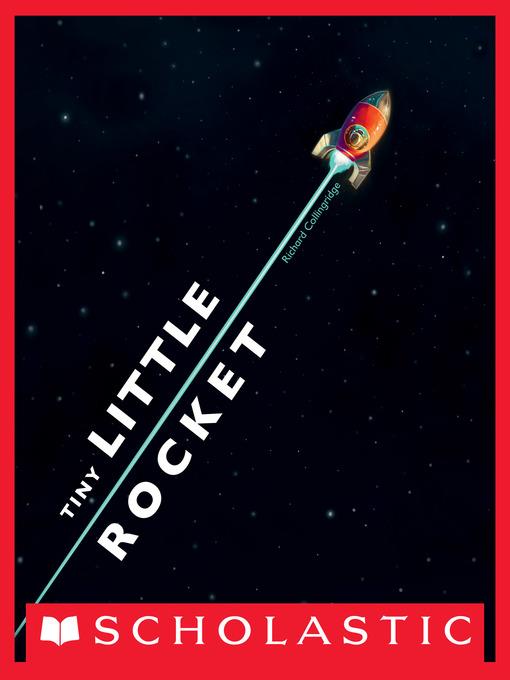
Tiny Little Rocket
فرمت کتاب
ebook
تاریخ انتشار
2018
Lexile Score
620
Reading Level
0-2
ATOS
3.2
Interest Level
K-3(LG)
نویسنده
Richard Collingridgeناشر
Scholastic Inc.شابک
9781338189506
کتاب های مرتبط
- اطلاعات
- نقد و بررسی
- دیدگاه کاربران
نقد و بررسی

Starred review from May 14, 2018
On a bright green hill outside of a town, an astronaut climbs aboard a tiny rocket. The rocket zips the explorer out past Mars as the story transitions to a richly detailed cockpit, leaving the reader to gaze outward with the pilot. Secondary to the broad expanse that spans the two-page spread and the many screens and levers tucked cozily inside the rocket, the pilot fades away, leaving young readers room to easily insert themselves into the story: “It whizzes out to deepest space/ while you hold on by the handle./ And there you’ll find the golden sun,/ our ever-burning candle.” Collingridge’s text offers a superb sense of rhythm and pacing with strong appeal as a readaloud, and his boldly colored illustrations hint at naturalism while retaining a comforting sense of whimsy. The peppy, little rocket—quickly dodging glowing meteors, navigating between vibrant planets, and zooming readers home to Earth—will leave adventurers eager for more journeys into outer space. Ages 3–5.

June 1, 2018
PreS-K-This title starts off with a teeny-tiny warning: "This book will make you want to BLAST OFF into outer space!" The tiny print is right-on in that the realistic yet whimsical illustrations will sweep up readers and make them want to visit the beautiful universe Collingridge has created. The story begins with the tiny little rocket blasting off on a rhyming adventure to Mars, the Sun, and narrowly avoiding a collision with a meteor before flying back to Earth. There the tiny little rocket unfurls a banner to say "Happy Birthday World!" celebrating the earth's birthday with a special three-page gatefold that shows the earth surrounded by sparkling fireworks. Taking advantage of the foldout, the reverse side shows our solar system with all nine planets and an explanation of how we celebrate the earth's birthday on New Year's Day. While the illustrations are mesmerizing, the minimal text is much more simple and is merely used as a way to get from one illustration to the next rather than telling a compelling story. In addition, the rhyming scheme doesn't always read smoothly. The illustrations alone should be enough to compel young readers to pick up this book. VERDICT Best for reading aloud, this is an exciting intergalactic adventure to add to picture book collections.-Jayna Ramsey, Douglas County Libraries in Parker, CO
Copyright 2018 School Library Journal, LLC Used with permission.

May 1, 2018
This rocket hopes to take its readers on a birthday blast--but there may or may not be enough fuel.Once a year, a one-seat rocket shoots out from Earth. Why? To reveal a special congratulatory banner for a once-a-year event. The second-person narration puts readers in the pilot's seat and, through a (mostly) ballad-stanza rhyme scheme (abcb), sends them on a journey toward the sun, past meteors, and into the Kuiper belt. The final pages include additional information on how birthdays are measured against the Earth's rotations around the sun. Collingridge aims for the stars with this title, and he mostly succeeds. The rhyme scheme flows smoothly, which will make listeners happy, but the illustrations (possibly a combination of paint with digital enhancements) may leave the viewers feeling a little cold. The pilot is seen only with a 1960s-style fishbowl helmet that completely obscures the face, gender, and race by reflecting the interior of the rocket ship. This may allow readers/listeners to picture themselves in the role, but it also may divest them of any emotional connection to the story. The last pages--the backside of a triple-gatefold spread--label the planets and include Pluto. While Pluto is correctly labeled as a dwarf planet, it's an unusual choice to include it but not the other dwarfs: Ceres, Eris, etc. The illustration also neglects to include the asteroid belt or any of the solar system's moons.A fair choice, but it may need some support to really blast off. (Picture book. 6-8)
COPYRIGHT(2018) Kirkus Reviews, ALL RIGHTS RESERVED.

























دیدگاه کاربران